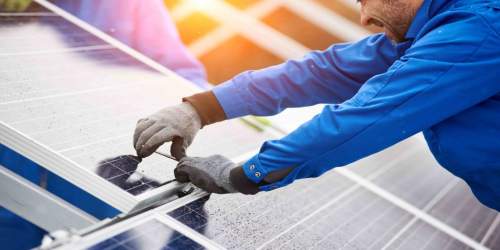Read Time : 8 Minutes
The Best Solar Battery Storage For Solar Panels
Since solar panels became financially viable one major stumbling block to the power they generate day to day has been how to use the energy when the sun isn’t shining. Up until relatively recently it has been impossible to store your excess solar energy safely and cost-effectively. However, there are now many solar battery storage solutions breaking on to the market. They vary in size and cost from a loaf of bread to around the size of a dishwasher and all have the ultimate aim of reducing your reliance on the National Grid. I'm sure you're asking yourself 'what is the best battery for me?' we aim to answer that question for you.
This development has the potential to make each home energy independent and to greatly reduce our reliance on large utility companies and the National Grid. It’s one of the big innovations of the last few years and it is beginning to gather pace.
In short, solar battery technology for solar panels could revolutionise the way we use energy. The good news is that in recent years the solar battery industry has really moved forward and with products from companies like Tesla and Samsung the future is starting to look much brighter.
Many suppliers and installers in the UK are now incorporating combined solar panels and solar battery / batteries when they visit a customer. These are still relatively early days but this technology could allow the solar industry to thrive without the need for subsidies paid to us for electricity we send back to the grid and allow us to use all the electricity our solar panels produce within the home/business. Potentially, allowing us to become energy self sufficient.
As solar panel and solar battery efficiency improves, a lot of homeowners across the UK should be able to cover all their electrical needs through solar power and battery storage solutions.
COMPARE PRICES FROM LOCAL INSTALLERS
Compare prices from local companies fast & free
Enter your postcode to compare quotes from leading professionals. We promise to keep your information Safe & Secure. Privacy Policy
What Are Solar Batteries?
Solar panels fit on your roof and collect energy from the sun. They use solar cells and an inverter to convert this energy to electricity and currently provide power for thousands of homes and businesses across the UK. Mostly, this electricity is produced when the sun is shining onto the panels and any that isn't used at the point of generation is then sent to the National Grid. It's usually sent to neighbouring properties and the utility companies then make a profit on it.
Homes and businesses with solar panels basically sell their electricity to the utility companies and receive a set amount through the Smart Export Guarantee (SEG) in return – the Grid acts as the storage mechanism ensuring we have power 24/7.
A solar battery stores the excess electricity generated by the solar panels that we don't use at the point of generation for use on demand, say in the evenings when the sun isn't shining or just when there's a higher demand than your panels can handle.
Why We Need Battery Storage
When solar power first started to emerge on the market, the concept of power storage and how to achieve it became a heavily discussed topic, and spent quite some time at the forefront of the minds of developers. However, the quick and easy solution of channelling excess power back to the grid took centre stage, combined with the feed-in tariff initiative, this led to a great number of people having panels installed on their roofs.
In addition to this, a number of businesses and organisations started to see solar panels as a way of boosting their image when it came to green energy, as well as a means of reducing their energy bills overall. However, a lot of this remained dependent on a subsidy that had the utility companies paying a tariff for the electricity that was produced and sent back to them. This works to an extent, the issue of course is that you get paid less per unit of electricity that you sent to the utility company than you pay per unit for electricity they send to you.
In some ways, this is a good thing as it will lead to the further research and development of systems that are independent of the grid. We are already seeing some of the benefits with efficient batteries that can be placed in homes or businesses being released. What this means is that we have a workable storage solution that should allow people to use the electricity they produce at any time they wish. All without needing to pay utility companies.
The Problems with Battery Storage
The main problem with battery storage for solar energy had always been rooted in their efficiency and how long they would last before they needed to be replaced, alongside the cost compared to remaining hooked up to the National Grid. Initially, the notion of a good return on your investment was incredibly limited, but over the past couple of years, there seems to have been quite a lot of things changing.
The main thing to note here is the dramatic decrease in price and increase in quality – a combination that you do not usually see. For example, the Tesla battery was priced at £10,000, and now it can be £5800 (not including installation). However, while the price has decreased dramatically, there are still issues with the concept of solar batteries. Most of this stems from the question “can you really leave the grid?”
A question that many have asked when faced with the prospect of a solar battery. After all, if you don’t produce enough power in the day and run out at night, you will be completely without power until the next morning if you are cut off from the grid. This is especially true when we take into consideration that you can expect around 20% of the power to be lost through natural means over the course of the day.
The Benefits of Battery Storage
If you decide to remain connected to the grid and your solar battery is essentially full, the excess will still be sent back to the grid, and you will still be eligible for payments for it. As the price of electricity rises, storing your excess means that you can become more cost effective, saving money and trying to dodge electricity bills from suppliers.
You can expect storage systems like this to become more efficient as energy prices rise. Battery storage is the first step to self-sufficiency.
The Renewable Energy Hub provides a directory of approved installation companies for you to contact.
https://www.renewableenergyhub.co.uk/search-installers
How Solar Battery Storage Works
Each of the solar battery banks is designed for a specific charge or discharge level. Some of them are manufactured wet cells, and others are manufactured sealed or gel cells – each of which has their own requirements. Always make sure you read the manual and ask the manufacturers for advice if you get stuck. When you decide to use a battery storage system, you should always make sure that it is the appropriate size and quality for the amount of solar power that it will be required to store. They should also be a deep cycle battery, unlike a car battery which is classed as a shallow cycle.
Using a battery that is too small can be incredibly dangerous. Which is part of the reason for getting a qualified professional to install the system. Modern batteries are now made of Lithium so can charge and discharge many more times and can store considerably more energy for their size. This technology requires no maintenance for the lifetime of the battery system, much like your mobile phone battery but many, many times the size. Batteries do make great ways to store the energy produced by solar power, and they can offer you the chance to be free from the grid.
DC batteries will need to be installed by an MCS accredited installer as this will most probably require an inverter change or special retrofit. For AC fed batteries, the process is slightly easier as the battery system operates separately from the PV system and has its own AC to DC inverter built in. These systems are slightly less efficient though but are often cheaper to buy initially.
The main point about in-house batteries is that they need to store enough electricity to get a home or business through that period when the solar panels are not generating electricity. The average home uses in the region of 3,500 kW/h per year or 9-13 kW/h per day and much of this is either early in the morning or in the evening (assuming the house is empty during the day). So, if your panels produce more electricity than is required during the day, a battery could cover the demand when the sun isn't shining.
How much electricity you use and when you use it, combined with the capacity of your solar panel array will define the number or capacity of batteries you have installed and the overall cost, if you want to make sure you are covered in times of greatest need.
A solar battery should be sized based on your energy consumption, the output of your solar panel array and the way you use electricity. If you get a small solar PV system and your daytime usage is high, say you're retired or working from home, a battery can be almost redundant. You will likely be using most, if not all of the electricity generated by the panels at the point of generation, thereby not having any left over to store in a solar battery. If you get a larger solar panel system, say 4-5kW and your daytime usage is a bit lower then a solar battery may become worthwhile. If you go for a large solar panel array, or you are out of the house during the day, that's when a battery really comes into its own. The excess electricity generated by your panels can be stored in the battery and used in the evenings when the sun is not shining.
More recently, batteries are being installed without solar panels. The concept here is to take electricity from the grid during the evening when your energy provider is offering a lower tariff and then use that electricity at peak times. It's worth noting that this solution relies on the energy company continuing to provide a lower off-peak tariff and you could get stuck with a redundant battery, should this change.
As with any renewable energy install, discuss the pay-back period with your installation company, they should provide you with an estimated ROI. The Renewable Energy Hub is always here to answer any questions you may have, or to double check any quotes you may have received.
Tesla Batteries
One of the prime movers in the solar power storage market has been Tesla, perhaps better known for their work on hybrid and electric cars to date. They have used the technology they have developed in the car manufacturing market to produce a lithium ion battery which they call Powerwall. They currently produce a 14kW battery that is easy to install and stores the electricity your solar panels generate. These are guaranteed for 10 years and can store the energy needed for a normal working home provided your solar panels produce enough to charge it.
Additional batteries can be added for those with higher electricity needs. The Powerwall also contains the inverter to convert DC current to AC. Weighing about the same as an average person, the Tesla Powerwall is certainly a large piece of kit and costs approx. £5,000 with an additonal £800 for the required gateway (not including installation and install prices vary wildly). Tesla began shipping their Powerwall range of solar battery to the UK in September 2015.
Will the price continue to drop? That depends on future advances in battery technology, production costs and whether the market continues to take up this kind of technology in large numbers and that is going to depend on a number of factors, including efficiency and longevity.
Samsung SDI Batteries and Other Providers
Tesla are not the only solar power battery units that are growing on the UK market. Samsung SDI have produced 5.5 kW and 8 kW versions. These have a warranty for five years and performance is guaranteed for 10.
Their Residential ESS system is said to be ideal for homes but they also produce much larger batteries up to utility level and will no doubt be one of the big players on the market over the next few years. Players such as LG Chem and even Mercedes Benz have also entered the market and their presence is starting to drive the prices down for solar storage, giving consumers a greater degree of choice.
There are now many solar battery systems available on the UK market and it can get a bit confusing for those showing an interest. Our general advice is to get a known brand, pop it into Google and see what people are saying. You can't beat peer review.
For the record, the best selling solar battery systems in the UK are:
- Tesla Powerwall 2.0
- Powervault 3
- GivEnergy
- SonnenBatterie 10
- LG Chem
- Enphase Encharge T Series
- Sunpower
Can You Go Off Grid?
This is the big challenge for solar battery technology – whether we can cut off our supply from the National Grid and actually be completely independent from the utility companies. The trouble is, whilst the market is beginning to expand and the technology is developing more rapidly, there is always the worry of what happens when your capacity over-reaches or the battery develops a fault. If you have disconnected yourself from the mains supply or built an off-grid property, then what do you do without any electricity at all?
Then there is the cost of maintaining and replacing batteries and the long term issues of basically being your own, independent energy producer.
The truth is that it's still a better option to have a grid supply but you can certainly get very close to being energy independent, or even accomplish it completely whilst maintaining a backup supply from the grid.
For businesses with larger systems that need someone onsite to maintain the power it can add even more costs – that of employing people to do the job and the problem if power is suddenly taken away and the consequent loss of sales and revenue.
Storage That’s Not Just for Solar
Installing a battery system without solar panels can be a viable option. The concept is that you can charge the battery from a lower off-peak tariff and then use that electricity during times of high peak. Pocketing the difference. You have to make sure that you'll be saving enough to pay of the initial cost of the battery and to generate some profit within the lifespan of the system. There is always the added concern that your utility company may change the tariff rates. That said, we have seen success with this and it's certainly growing in popularity.
A battery storage system can be used for any renewable system, including hydroelectric and wind turbines. The unique position of solar is that it only produces sufficient electricity when the sun is shining but storage could also be used for other energy systems to help with times when there is a strain on capacity; for instance, when a factory has a large order to complete.
The Future of Solar Energy Storage
Intelligent battery storage may well be the future of greater energy independence, at least in the coming decades. Many manufacturers are now beginning to produce digital technologies that monitor energy usage and combine that with power production to make sure that electricity is available as and when needed.
For instance, in an average home where everyone is working, more power is used in the morning and in the evening than during the day, so batteries can be a common sense investment. Businesses will have other peak demands that will benefit from a more controlled energy storage system. More efficient solar batteries with a longer lifespan and better capacity will also help make the break from a total reliance on the National Grid and lead us to more independent electricity production.
Currently and in the immediate future we still need a hybrid mechanism that stores electricity but also has access to the National Grid. That will then reduce the amount of electricity that requires a payment to the utility companies. In the longer term, as solar panel and solar battery efficiency increases, we may have a situation where localised energy storage will indeed mean that many of us can become independent of the National Grid.
The question will be how the installation is funded and whether universal access can be created which means we all benefit from clean energy that is homemade. You can find local installers and suppliers of solar panels and storage systems on our database.
Want to Know More?
Have you found yourself interested in solar panels? If you want to know more then click on the further reading links on the right. Alternatively, you can always call us using the number at the top of this page.
Find a local installer
Welcome to the biggest directory of UK renewable energy companies





 How Much do Solar Panel Systems Cost in 2024?
How Much do Solar Panel Systems Cost in 2024?







